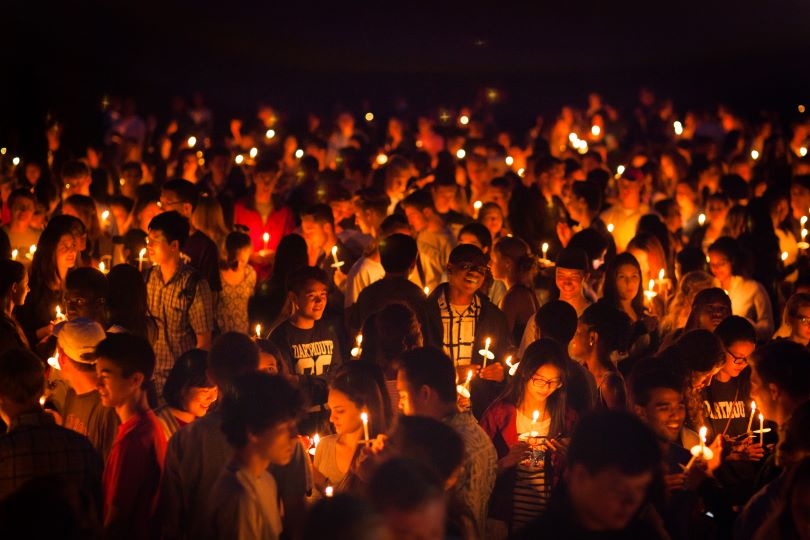General Information:
Title: Twilight Ceremony
Form of Folklore: Customary, ceremony
Language: English
Place of Origin: Hanover, NH, United States
Informant: L.A.
Date Collected: October 29th, 2021
Informant Data:
L.A. is a 21-year-old member of the Dartmouth class of 2022. She is a student-athlete on the rugby team, and is a double-major in geography and anthropology. At Dartmouth she is a tour guide, a snowboard instructor, and works for the Sustainability Office. She is from Colorado Springs, CO and enjoys the outdoors, and is very grateful for Dartmouth’s engagement with the surrounding nature. She does not come from a tradition-heavy background, and has thus really enjoyed partaking in the Dartmouth traditions. The second tradition she experienced at Dartmouth was the Twilight Ceremony, after participating in the DOC Trips.
Contextual Data:
– Social Context: The first thing L.A. did upon arriving at Dartmouth was participating in Dartmouth’s Freshman ‘Orientation-Week’. This program is aimed at introducing the freshman to the various aspects and operations of Dartmouth College. On the Sunday before the first day of fall-term classes, the last day of Orientation-Week, she participated in the ‘Twilight Ceremony’. The ceremony is organized by the Tucker Center in collaboration with the Collis Student Center, and all incoming freshmen participate. This was Lannan’s first experience with an organized Dartmouth tradition, and she really enjoyed participating alongside her whole class.
– Cultural Context: The Dartmouth experience is heavily influenced by many traditions, whereof some are organized and some occur naturally, and some are repeated every year by members of all classes and some are aimed specifically at freshman. Particularly, Dartmouth places heavy emphasis on freshman-only organized traditions as part of an initiation rite to make the freshman feel introduced as part of the collective Dartmouth community. The Twilight Ceremony incorporates the use of candles and two socially-significant locations on campus (the Green and BEMA), making it very Dartmouth specific rather than a general ‘you are now a college student’ initiation rite.
Item:
The Twilight Ceremony is organized and hosted by the Tucker Center and the Collis Center, and it marks the end of the ‘Orientation Week’ program the evening before fall term classes begin. All freshmen are gathered on the Dartmouth Green and provided with an unlit candle. A selected member of the recently graduated class will literally pass the flame from their candle to members of the incoming class, from candle to candle. All the freshmen walk in the dark to BEMA, only illuminated by the wave of flickering flames. At BEMA, a senior student offers a personal reflection on their experience transitioning from a freshman to a senior. The ceremony concludes with the singing of the Alma Mater and the extinguishing of the candles, to mark that students have now formally begun their Dartmouth journey.
Associated File:

Image courtesy of Dartmouth, the William Jewett Tucker Center
Transcript:
Collector: “Are there any other traditions we haven’t discussed that you think are important to freshman fall at Dartmouth?”
Informant: “The candlelight ceremony was the first tradition I experienced after Trips, and because it was a one-time event it almost felt as the most ‘proper’ tradition. It felt very culty seeing all the freshmen walk into the woods with candles and singing the Alma Matter made me feel initiated into a Dartmouth cult. But it was also very fun, as it kind of cemented our class together and gave me the feeling of ‘whatever happens, we are all in this together’. Because none of my friends at other schools did anything like this with their whole class, it made me feel part of a very tight-knit and special community regardless of who there I would end up being friends with or not.”
Collector Comment:
I had a very similar experience when I participated in the Twilight Ceremony. Although I did not know any of the students around me, I felt as part of a collective group that was embarking on a college journey together in the woods. The Twilight Ceremony is a very formal execution of an initiation rite, including all the stages in a rite of passage.
Collected By:
Una Westvold
Oslo, Norway
Hanover, NH
Dartmouth College
RUSS 013
Fall 2021
